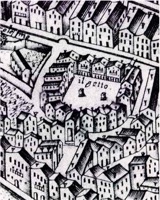Difference between revisions of "Ghetto"
(Created page with 'File:lighterstill.jpgright|frame ==Origin== Italian, from [http://en.wikipedia.org/wiki/Venice Venetian] dialect ''ghèto'' island where [[Je...') |
m (Text replacement - "http://" to "https://") |
||
| Line 2: | Line 2: | ||
==Origin== | ==Origin== | ||
| − | Italian, from [ | + | Italian, from [https://en.wikipedia.org/wiki/Venice Venetian] [[dialect]] ''ghèto'' island where [[Jews]] were forced to live, [[literally]], [https://en.wikipedia.org/wiki/Foundry foundry] as the first ghetto founded in Venice in 1516 was on the site of a foundry. (located on the island), from ''ghetàr'' to cast, from [[Latin]] ''jactare'' to throw |
| − | *[ | + | *[https://en.wikipedia.org/wiki/17th_century 1611] |
==Definitions== | ==Definitions== | ||
*1: a quarter of a [[city]] in which [[Jews]] were formerly required to live | *1: a quarter of a [[city]] in which [[Jews]] were formerly required to live | ||
| Line 10: | Line 10: | ||
:b : a situation that resembles a ghetto especially in conferring inferior [[status]] or [[limiting]] [[opportunity]] <the pink-collar ghetto> | :b : a situation that resembles a ghetto especially in conferring inferior [[status]] or [[limiting]] [[opportunity]] <the pink-collar ghetto> | ||
==Description== | ==Description== | ||
| − | The term '''ghetto''' became more widely used for [ | + | The term '''ghetto''' became more widely used for [https://en.wikipedia.org/wiki/Ghettos_in_occupied_Europe_1939-1944 ghettos in occupied Europe in 1939-1944], when the Germans reused historic ghettos to confine [[Jews]] prior to their [[transportation]] to [https://en.wikipedia.org/wiki/Concentration_camp concentration and death camps] during the holocaust. The definition of "ghetto" still has a similar [[meaning]], but the broader range of [[social]] situations, such as any [[poverty]]-stricken urban area. |
| − | The [[development]] of ghettos in [[America]] is closely [[associated]] with different waves of [[immigration]] and internal urban [[migration]]. The [ | + | The [[development]] of ghettos in [[America]] is closely [[associated]] with different waves of [[immigration]] and internal urban [[migration]]. The [https://en.wikipedia.org/wiki/Irish_Americans Irish] and [https://en.wikipedia.org/wiki/German_American German] immigrants of the mid-19th century were the first [[ethnic]] groups to form ethnic [[enclaves]] in America’s cities. This was followed by large numbers of immigrants from Southern and Eastern Europe, including many [https://en.wikipedia.org/wiki/Italian_American Italians] and [https://en.wikipedia.org/wiki/Polish_American Poles] between 1880 and 1920. These later European immigrants actually were more impregnated than blacks in the early [https://en.wikipedia.org/wiki/20th_century twentieth century]. Most of these remained in their established immigrant communities, but by the second or third [[generation]], many families were able to relocate to better housing in the [https://en.wikipedia.org/wiki/Suburb suburbs] after [[World War II]], as they assimilated and prospered. |
| − | These [[ethnic]] ghetto areas included the [ | + | These [[ethnic]] ghetto areas included the [https://en.wikipedia.org/wiki/Lower_East_Side#The_Lower_East_Side_as_an_immigrant_neighborhood Lower East Side] in Manhattan, New York, which later became notable as predominantly Jewish, and [https://en.wikipedia.org/wiki/East_Harlem#History East Harlem], which became home to a large Puerto Rican community in the 1950s. [https://en.wikipedia.org/wiki/Little_Italy Little Italys] across the country were predominantly Italian ghettos. Many Polish immigrants moved to sections like Pilsen of Chicago and [https://en.wikipedia.org/wiki/Polish_Hill_(Pittsburgh) Polish Hill] of Pittsburgh, and [https://en.wikipedia.org/wiki/Brighton_Beach Brighton Beach] is the home of mostly Russian and Ukrainian immigrants.[https://en.wikipedia.org/wiki/Ghetto] |
[[Category: History]] | [[Category: History]] | ||
[[Category: Sociology]] | [[Category: Sociology]] | ||
Latest revision as of 23:56, 12 December 2020
Origin
Italian, from Venetian dialect ghèto island where Jews were forced to live, literally, foundry as the first ghetto founded in Venice in 1516 was on the site of a foundry. (located on the island), from ghetàr to cast, from Latin jactare to throw
Definitions
- 1: a quarter of a city in which Jews were formerly required to live
- 2: a quarter of a city in which members of a minority group live especially because of social, legal, or economic pressure
- 3a : an isolated group <a geriatric ghetto>
- b : a situation that resembles a ghetto especially in conferring inferior status or limiting opportunity <the pink-collar ghetto>
Description
The term ghetto became more widely used for ghettos in occupied Europe in 1939-1944, when the Germans reused historic ghettos to confine Jews prior to their transportation to concentration and death camps during the holocaust. The definition of "ghetto" still has a similar meaning, but the broader range of social situations, such as any poverty-stricken urban area.
The development of ghettos in America is closely associated with different waves of immigration and internal urban migration. The Irish and German immigrants of the mid-19th century were the first ethnic groups to form ethnic enclaves in America’s cities. This was followed by large numbers of immigrants from Southern and Eastern Europe, including many Italians and Poles between 1880 and 1920. These later European immigrants actually were more impregnated than blacks in the early twentieth century. Most of these remained in their established immigrant communities, but by the second or third generation, many families were able to relocate to better housing in the suburbs after World War II, as they assimilated and prospered.
These ethnic ghetto areas included the Lower East Side in Manhattan, New York, which later became notable as predominantly Jewish, and East Harlem, which became home to a large Puerto Rican community in the 1950s. Little Italys across the country were predominantly Italian ghettos. Many Polish immigrants moved to sections like Pilsen of Chicago and Polish Hill of Pittsburgh, and Brighton Beach is the home of mostly Russian and Ukrainian immigrants.[1]
